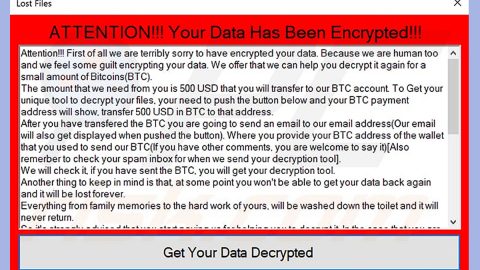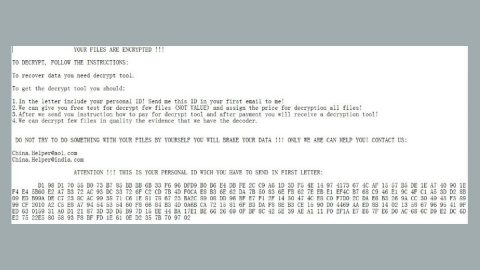What is Decoder ransomware? And how does it perform its attack on the infected computer?
Decoder ransomware is another file-encrypting threat related to Globe Imposter ransomware group. This new ransomware was first observed in early November 2017. Once it is able to infect the targeted computer, it usually targets files with the following extensions:
.3gp, .7z, .apk, .avi, .bmp, .cdr, .cer, .chm, .conf, .css, .csv, .dat, .db, .dbf, .djvu, .dbx, .docm, ,doc, .epub, .docx .fb2, .flv, .gif, .gz, .iso .ibooks,.jpeg, .jpg, .key, .mdb .md2, .mdf, .mht, .mobi .mhtm, .mkv, .mov, .mp3, .mp4, .mpg .mpeg, .pict, .pdf, .pps, .pkg, .png, .ppt .pptx, .ppsx, .psd, .rar, .rtf, .scr, .swf, .sav, .tiff, .tif, .tbl, .torrent, .txt, .vsd, .wmv, .xls, .xlsx, .xps, .xml, .ckp, .zip, .java, .py, .asm, .c, .cpp, .cs, .js, .php, .dacpac, .rbw, .rb, .mrg, .dcx, .db3, .sql, .sqlite3, .sqlite, .sqlitedb, .psd, .psp, .pdb, .dxf, .dwg, .drw, .casb, .ccp, .cal, .cmx, .cr2.
This malware uses a strong encryption algorithm though it’s still unknown which cipher it uses in its attack. It also appends the .decoder extension on the affected files. Following its encryption, it drops a text file named Instructions.txt containing the ransom note – here’s its full context:
“Your personal ID
[RANDOM CHARACTERS]
All your files have been encrypted due to a security problem with your PC.
If you want to restore them, write us to the e-mail:[email protected]
Additional Mailing Address e-mail:[email protected]
How to obtain Bitcoins
** The easiest way to buy bitcoins is LocalBitcoins site. You have to register, click ‘Buy bitcoins’, and select the seller by payment method and price.
** hxxps://localbitcoins.com/buy_bitcoins
** Also you can find other places to buy Bitcoins and beginners guide here:
** hxxp://www.coindesk.com/information/how-can-i-buy-bitcoins/
Free decryption as guarantee
** Before paying you can send to us up to 1 files for free decryption. Please note that files must NOT contain valuable information and their total size must be less than 1Mb
Attention!
** Do not rename encrypted files.
** Do not try to decrypt your data using third party software, it may cause permanent data loss.
** Decryption of your files with the help of third parties may cause increased price (they add their fee to our) or you can become a victim of a scam.”
As you can see, Decoder’s ransom note starts with a personal ID number informing its victims that the files in the computer are encrypted because of some “security problems” in the computer and that in order to fix the so-called security problems and recover the encrypted files, victims are encouraged to send an email to [email protected] or [email protected] email addresses. Security experts advised victims to never reach out to these crooks and pay the demanded ransom although it isn’t stated how much these crooks actually want. There is no guarantee that these crooks will really give you the decryption tool or the decryption key to recover your files as they are not known to keep their promises.
How does Decoder ransomware spread?
Decoder ransomware is likely to sneak into your computer using malicious spam emails. Even though there are various ways in spreading ransomware infection, spam email is the always go-to method for cyber criminals in proliferating their malicious infections. They often attach infected attachments like a malicious executable file or a corrupted macro-enabled file responsible in installing Decoder ransomware into the system.
Refer to the removal guide below to eliminate Decoder ransomware.
Step 1: Open the Windows Task Manager by pressing Ctrl + Shift + Esc at the same time. Proceed to the Processes tab and look for suspicious processes that can be related to the Decoder Ransomware.

Right-click on the processes then click Open File Location and scan them using a powerful and trusted antivirus like SpyRemover Pro. After opening their folders, end their processes and delete their folders. If the virus scanner fails to detect something that you know is suspicious, don’t hesitate to delete it.
Step 2: Open Control Panel by pressing Start key + R to launch Run and type appwiz.cpl in the search box and click OK.

Step 3: Look for Decoder ransomware or any malicious program and then Uninstall it.

Step 4: Hold down Windows + E keys simultaneously to open File Explorer.
Step 5: Go to the directories listed below and then look for the corrupted files such as its ransom note, “!HOW_TO_UNLOCK_FILES!.html”created by the malware.
- C:\Users\(your pcname)\AppData\Roaming
- %TEMP%.
- %USERPROFILE%\Downloads
- %USERPROFILE%\Desktop
Step8. Close the File Explorer.
Before you proceed to the next steps below, make sure that you are tech savvy enough to the point where you know exactly how to use and navigate your computer’s Registry. Keep in mind that any changes you make will highly impact your computer. To save you the trouble and time, you can just use PC Cleaner Pro, this system tool is proven to be safe and excellent enough that hackers won’t be able to hack into it. But if you can manage Windows Registry well, then by all means go on to the next steps.
Step9. Tap Win + R to open Run and then type in regedit in the field and tap enter to pull up Windows Registry.

Step10. Navigate to the following path:
- HKEY_CURRENT_USER\SOFTWARE\Microsoft\Windows\CurrentVersion\Run
- HKCU\SOFTWARE
- HKCU\SOFTWARE\WOW6432Node
Step11. Delete the registry keys and sub-keys created by Decoder ransomware.
Step12. Close the Registry Editor and empty your Recycle Bin.
Try to recover your encrypted files using the Shadow Volume copies
Restoring your encrypted files using Windows’ Previous Versions feature will only be effective if Decoder ransomware hasn’t deleted the shadow copies of your files. But still, this is one of the best and free methods there is, so it’s definitely worth a shot.
To restore the encrypted file, right-click on it and select Properties, a new window will pop-up, then proceed to Previous Versions. It will load the file’s previous version before it was modified. After it loads, select any of the previous versions displayed on the list like the one in the illustration below. And then click the Restore button.

It is important to make sure that nothing is left behind and that Decoder ransomware is completely removed use the following antivirus program. To use it, refer to the instructions below.
Perform a full system scan using SpyRemover Pro. To do so, follow these steps:
- Turn on your computer. If it’s already on, you have to reboot
- After that, the BIOS screen will be displayed, but if Windows pops up instead, reboot your computer and try again. Once you’re on the BIOS screen, repeat pressing F8, by doing so the Advanced Option shows up.
- To navigate the Advanced Option use the arrow keys and select Safe Mode with Networking then hit
- Windows will now load the SafeMode with Networking.
- Press and hold both R key and Windows key.
- If done correctly, the Windows Run Box will show up.
- Type in explorer http://www.fixmypcfree.com/install/spyremoverpro
A single space must be in between explorer and http. Click OK.
- A dialog box will be displayed by Internet Explorer. Click Run to begin downloading the program. Installation will start automatically once download is done.
- Click OK to launch it.
- Run SpyRemover Pro and perform a full system scan.
- After all the infections are identified, click REMOVE ALL.
- Register the program to protect your computer from future threats.

















